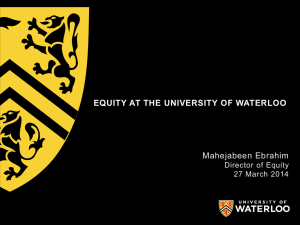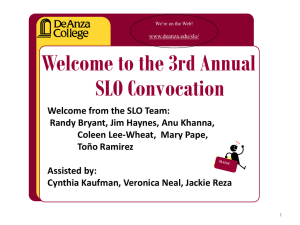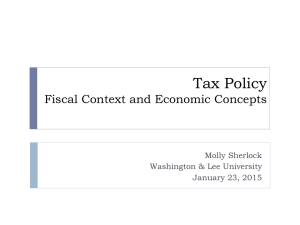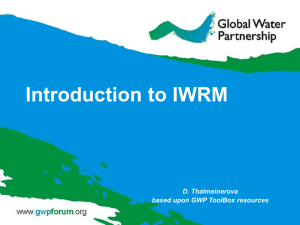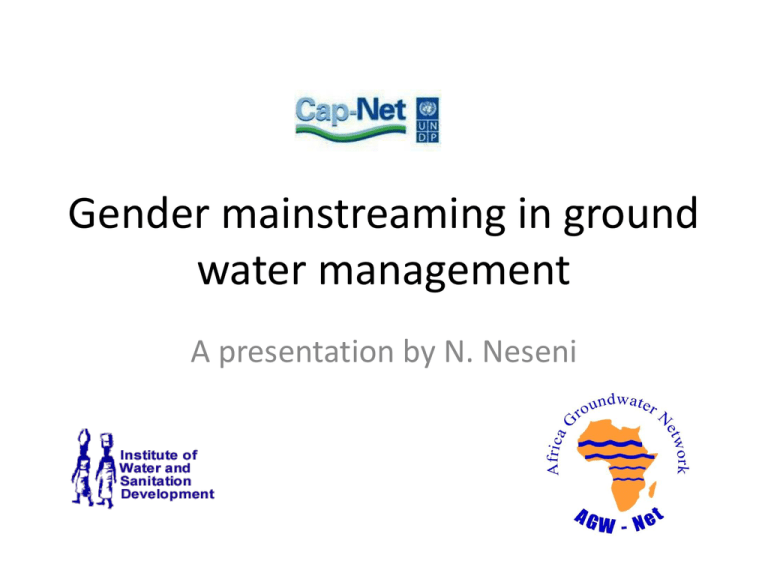
Gender mainstreaming in ground
water management
A presentation by N. Neseni
Purpose of the presentation
• To highlight the key cross cutting issues of
gender , ground water management
• To create awareness and interest among water
professionals, researchers , managers and
planners so that they may consider these
issues not just as “other consideration” but as
key to realization of ground water
management goals and objectives.
Why gender matters in water
management
• Dealing with water scarcity, competition for
water and pollution, the water manager has to
find a way to fulfill the needs and reduce the
impacts.
• Poor women and men are affected and
impacted on by water, economically, socially
and environmentally
The IWRM has three pillars
Environmental sustainability
Environmental sustainability means assuring the capacity of
nature to support life. Within the context of IWRM this means a
healthy water cycle, adequate water for nature, and less water
pollution. Forests and wetlands, among other ecosystems, help
regulate water flow and quality. Wise efforts to manage water
resources sustainably and ensure long-term water availability
must include integrated actions to protect ecosystems and
ensure environmental sustainability. On contrary, poor
management of water resources will result in largely negative
and often irreversible changes to the environment. Long-term
water availability requires that ecosystems are able to continue
to regulate water quality and quantity
Economic efficiency
Economic efficiency Water is vital for economic
and social development and is indispensable
to sustain and increase urban and rural
livelihood activities. Given increasing water
scarcity, the choice as to how each drop
should be allocated and managed becomes
central to maximizing social and economic
benefits and ensuring sustainability.
Economic efficiency
This effort also includes sectoral and cross
sectoral actions for cleaner production,
water reuse and recycling recognizing that
freshwater is a limited resource, and
investment in water projects must be viable.
Economic efficiency also refers to financial
sustainability to build, operate and maintain
the diverse projects and facilities required to
improve water access and assure water
quality and quantity over the long-term
through cost recovery and payment systems.
Social equity
Social equity Water is a basic human need. It is also a
central part of the basic rights all people are entitled
to under the Universal Declaration of Human Rights.
When considered in this light, social equity is
embedded in actions that support the sustainable
management and use of water resources. Social
equity requires that a fair share of water benefits and
responsibilities be transmitted to women and men,
poor and rich, young and old.
Social equity
This means fair opportunities to access, use and
control water resources, as well as equitable
acceptance of responsibility for the negative
side effects produced so as to avoid placing
higher burdens on the poor or disadvantaged
members of society.
In its scarcity –the poor men and
women bear the heaviest losses
In its abundance national infrastructure is destroyed
placing heavy burden on social budgets
In its poor quality, down stream users often
poor quality
Due to poor management poor men and women bear
the burden and pay price in health
Defining gender
• Can you please write on a piece of paper what
it is that you have wished to do had you been
the opposite sex.
• What stops you from doing that ?
• Discuss what seems to be emerging
Defining Gender
• Most of the barriers that stop us are social
rather than biological. Society has
expectations of how we should behave
because of our sexual orientation.
• Consequently we are trained through
socialization to behave in a certain manner
because we were born with male of female
organs.
Defining gender
sex vs. gender
Sex
Biological
Given by birth
Therefore
cannot be changed
Example
Only women can give birth
Only men can produce sperms
and Impregnate
Gender
Cultural
Learned through socialization
Therefore
Can be changed
Example
women and men can work as water
managers, latrine builders, drillers,
planners
Women and men can take care of the
sick, elderly and children
Defining gender Contd
• `Gender can thus be defined as “
socially determined attributes,
roles, activities and responsibilities
connected to being male or female
in a society.”
• gender attributes vary from society
to society,
• are largely influenced by such
factors as class, religion, ethnicity
etc.
• are not static and change over
time being influenced by factors
such as social, economic and
political influences
Global commitments
Importance of gender has been recognized
globally:
• UN conference on water at Mar del Plata 1997
• IDWSS decade 1981-90
• Conference on water and environment Dublin
1992
• Agenda 21
• International Decade for action on water and
life 2005-2015
Gender overview
• MDGS
• CEDAW
• Members states have various
strategies on gender
mainstreaming
• SADC has the
RISDP,ECOWAS,OAU,
NEPAD,AMCAO
• However…. All countries
characterised by gender
disparities …. Political, economic,
social and cultural spheres.
Why its necessary to consider cross
cutting issues
“Anyone who can solve
the water challenges in
this world deserves a
double Nobel prize “
Prof. Andreas SolloziNargi Rector UNESCO
IHE 11th symposium
Victoria Falls 2010
Women in development (WID)
Gender and development (GAD)
1 Approach
Views women as centre of the problem
An approach to development of men and
women
2 The focus
women
Relations between men and women
3 The problem
Exclusion of women form dev. process
Unequal relations of power preventing
equitable dev. & full part.
4 The goal
More efficient and just dev.
Equitable and sustainable dev with women
and men as decision makers
The solution
Integrate women into existing dev process
Empower disadvantaged & transform
unequal relations
6 The strategies
Women’s projects
Women’s components
Integrated projects
Increase women's productivity
Increase women’s ability to look after the
H/H
Identify and address practical needs
Address women’s and men’s strategic
needs
Address strategic interest of the poor
Gender issues
•
•
•
•
•
•
•
•
Access and control over resources
Literacy and access to education
Access to and control over land
Capital or financial services
Skilled and unskilled work
Paid and unpaid labour
Gender budgets
Decesion making (water using vs
decesion making community
• Technology and participation
Water is a finite and valuable resource essential to sustaining life,
development and the environment
Linking HIV, AIDS and gender to IWRM
Gender
When a resource is finite there is competition and it
is the poor and weak who often loose out
Water and land are also intrinsically linked and
women while they till the land have little control
over that land and therefore over water resources,
allocation, charges etc
Women traditionally are custodians of water and
environment and their role has positive effects on
sustainable use. Sidelining them leads to negative
usage
Women play a central part in the provision, management
and safeguarding of water
Women need capacity to be able to participate
An enabling environment that allows them to participate such as
timing of meetings, venue of meeting
Other facilities that allow them to continue with their care giving
role
Participation is also influenced by environment, complexity of
technology
Issues such as language have an impact on who participates and
at what level of participation
Water has an economic value in all its competing uses and
should be recognized as an economic & social good
Gender
Women largely use water for social issues in which it is difficult
to attach a monetary value and yet is important for health and
perpetuation of humanity.
Commoditization of water may sideline the poor men and
women
Delineation of water into domestic and productive use is
artificial at local level. Women who often are care givers will
want to conduct domestic and productive activities within a
convenient distant to homestead
Water development and management should be based on
participatory approach involving users, planners and policy makers
at all levels
gender
There is a clear decision making group in IWRM and water
using group
Instruments for participatory planning not in place.
Stakeholder participation is a concept that is nice and generally
agreed on. The practical approach where there are log frames,
timelines means in reality it is not applied. SADC has produced
guidelines on stakeholder participation
Women and poor are often multi tasking making participation
difficult
Gender mainstreaming
• Know the difference between Gender equality and gender
equity
equality of opportunity and equity of outcomes:
• equality of opportunity: this means that women , infected
should have equal rights and entitlements to human, social,
economic and cultural development, and an equal voice in
civic and political life
equity of outcomes: this means that the exercise of these rights
and entitlements leads to outcomes which are fair and just.
Gender Analysis
Gender analysis
- a methodology to identify the roles and
responsibilities of the various members of the
household, their access and control over
resources, benefits under prevailing
institutional norms and mechanisms.
Different gender policies and strategies
•
•
•
•
Gender aware policies
Gender neutral policies
Gender redistribute policies
Gender blind policies
Malawi Case Study
• In the 1980s the Malawian gvt designed an
innovative system of community mgt for water
supply to low income h/holds.
• H/holds in 50 districts received water, but water
bills were not paid.
• Taps were opened at inappropriate times.
• Water committees seldom met.
• Investigations showed that, prior to this project,
local men had had little or nothing to do with
water mgt.
Malawi example
• However, when the externally driven project was
initiated, the men took control & the women took
a back seat.
• Tap committees were made up of 90% men,
many of whom were away most of the time.
• Efforts were made to integrate women into the
process & guidelines for 60% women were set
for tap committees.
• Consultation with women was done separately,
& male & female extension officers were used.
The Result
• Payment of water bills increased.
• Women became active & long serving
members of tap committees.
• Special training courses were organised
for women in leadership, problem solving,
financial mgt, hygiene & sanitation, &
operation & maintenance.
• Tap committees met regularly &
attendance was good.
Malawi example
• Hygiene & sanitation improved. Taps were
opened & closed to the satisfaction of
users.
• There are many such examples of the
benefits of gender sensitive policies giving
rise to significant benefits at the local level.
Benefits of Gender Mainstreaming
• Benefits arising from a gender sensitive
approach generally lists five major areas
of benefit:
• efficiency,
• effectiveness,
• equity,
• sustainability &
• development at large.
Addressing gender for sustainable development
Processing:
food,
diseases,
ecosystem
balance
Livelihoods
•Food
•Fuel
•Freshwater
•soil
society
Manufactured
financial capital
Human
capital
Environmen
t natural
capital
Social
capital
Assimilative
capacity
Sink for
wastes
Gender mainstreaming tools
• Harvard framework
• POP framework
• Moser framework
- Basically looking at who does what? who
benefits who makes decisions? who pays the
price?
HAVARD ANALYTICAL FRAMEWORK
Aim is to demonstrate that there is an economic
case for allocating resources to men and women
thus planners will design more efficient projects
and improve productivity. It looks at roles and
responsibilities, access and control, influencing
factors.
PEOPLE ORINTED PLANNING FRAMEWORK
Similar to Harvard analytical framework
Aim is to ensure that there is equitable distribution of
resources and services
Was adapted by UN for refugee situations to ensure
that there is efficient use of donor resources and
promote appropriate targeting.
Influenced by:
Change
Participation socio-demographic analysis
Uses activity profile and use and control of resources
WHERE
AND WHEN
ARE THEY
USEFUL
DATA COLLECTION AND ANALYSIS
Both frameworks are useful for micro level analysis
especially for data collection and analysis. More useful for
projects rather than programmes. Can be used at any
stage of the project cycle.
TRAINING
Can be used in training to demonstrate the complexity of
people’s lives
WHERE
AND WHEN
ARE THEY
USEFUL
AS GENDER NEUTRAL ENTRY POINTS
Can be used for opening dialogue about gender
disparities with those who do not want to acknowledge
gender issues. The power dynamics are based on fact
and not theory.
IN COMMUNICATION
The gender framework relies on economic argument for
most efficient allocation of resources. The language is
similar to that of economists and this may be useful in
talking to people influenced by economic efficiency.
MOSER FRAMEWORK
At the heart of this is ‘gender planning”
and the assumption is that planning is
not only a technical but both political
and technical in nature, that there is
conflict in planning, it is transformatory
and that it is a debate.
3 categories of this framework;
Women’s Triple Role, practical and
strategic gender needs, categories of
WID/GAD matrix
TRIPPLE ROLE:PRODUCTIVE, REPRODUCTIVE, COMMUNITY
MANAGEMENT
STRATEGIC AND PRACTICAL NEEDS
WID/GAD- DISTINGUSHING BETWEEN THE AIMS
OF THE PROGRAMME
WELFARE APPROCAH- acknowledging women in their
reproductive role, passive beneficiaries of development
programmes/projects
EQUITY- USED BY UN FOR PROMOTING EQUALITY
(76-850 Direct state intervention to promote involvement
of women in development tries to meet strategic needs of
women through political and economic autonomy. Seen
as threatening more on feminism and mostly westernalienates men.
ANTI POVERTY – aim is to see that poor women move
out of their poverty by increasing their productivity.
Problem is women’s poverty and not that of
subordination. Tries to meet practical gender needs of
raising incomes.
EFFICIENCY- Ensure that development is more efficient
and effective by harnessing women’s economic
contribution. It assumes women’s participation as gender
equity. That women’s time is elastic.
EMPOWERMENT – empower women through
supporting their own initiatives thus fostering selfreliance. Women’s experiences influenced by factors
such as class, age, religion. Seeks to meet both practical
and strategic gender needs.
Use of the tool
PLANNING
TRAINING
Why does it appeal?
Moves planning beyond
technical
Challenges inequality
Talks to planners in their own
language
Practical and strategic gender needs a good way of assessing
impact.
Triple role makes all work visible
Distinguishes between policy approaches
BUT DOES IT MATER
WHICH TOOL YOU USE
NOOOO- LARGELY
DEPENDS ON
OBJECTIVES




